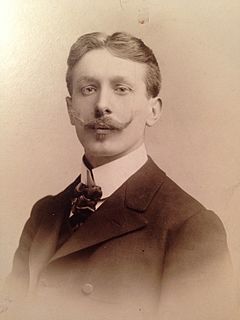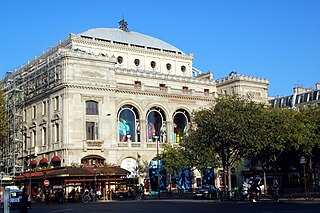
Joseph Maurice Ravel was a French composer, pianist and conductor. He is often associated with impressionism along with his elder contemporary Claude Debussy, although both composers rejected the term. In the 1920s and 1930s Ravel was internationally regarded as France's greatest living composer.

Albert Charles Paul Marie Roussel was a French composer. He spent seven years as a midshipman, turned to music as an adult, and became one of the most prominent French composers of the interwar period. His early works were strongly influenced by the impressionism of Debussy and Ravel, while he later turned toward neoclassicism.

Henri Constant Gabriel Pierné was a French composer, conductor, and organist.
Tzigane is a rhapsodic composition by the French composer Maurice Ravel. It was commissioned by and dedicated to Hungarian violinist Jelly d'Arányi, great-niece of the influential violin virtuoso Joseph Joachim. The original instrumentation was for violin and piano. The first performance took place in London on April 26, 1924 with the dedicatee on violin and with Henri Gil-Marchex at the piano.

Rapsodie espagnole is an orchestral rhapsody written by Maurice Ravel. Composed between 1907 and 1908, the Rapsodie is one of Ravel's first major works for orchestra. It was first performed in Paris in 1908 and quickly entered the international repertoire. The piece draws on the composer's Spanish heritage, and is one of several of his works set in or reflecting Spain.

Marguerite Long was a French pianist and teacher.
Lucien Durosoir was a French composer and violinist whose works were rediscovered thanks to manuscripts found by his son Luc.
Maurice Ravel completed his String Quartet in F major in early April 1903 at the age of 28. It was premiered in Paris in March the following year. The work follows a four-movement classical structure: the opening movement, in sonata form, presents two themes that occur again later in the work; a playful scherzo second movement is followed by a lyrical slow movement. The finale reintroduces themes from the earlier movements and ends the work vigorously.
Piero Coppola was an Italian conductor, pianist and composer.

The Pasdeloup Orchestra is the oldest symphony orchestra in France.

Léo-Pol Morin was a Canadian pianist, music critic, composer, and music educator. He composed under the name James Callihou, with his most well known works being Suite canadienne (1945) and Three Eskimos for piano. He also composed works based on Canadian and Inuit folklore/folk music and harmonized a number of French-Canadian folksongs. Victor Brault notably transcribed his Inuit folklore inspired Chants de sacrifice for choir and 2 pianos.
Le Déluge, Op. 45, is a French oratorio written by Camille Saint-Saëns in 1875 and scored for orchestra, chorus, and soloists. The libretto, a "poème biblique" by Louis Gallet, is based on the biblical story of Noah and the flood. It was premiered at the Théâtre du Châtelet on March 5, 1876, under the direction of Edouard Colonne.
Gaston Poulet was a French violinist and conductor. He played an important part in the diffusion of the contemporary music of the first half of the 20th century. His son Gérard Poulet, born in 1938, was also a violinist.

Gaston Blanquart was a French classical flautist as well as a music pedagogue.
Jean Doyen was a French classical pianist, pedagogue and composer.
Olivier Charlier is a French classical violinist.
Eugénie Élise Vergin sometimes also known under the name Élise Colonne or Alice Colonne was a French singer and singing teacher.
Éditions Durand are a music publishing company of French origin, among the most important in the field of classical music, which includes three previously independent publishers:















